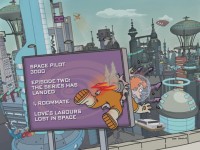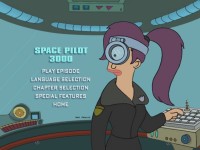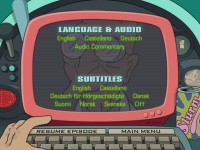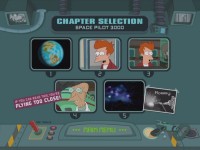
22.02.2015 #588
German Versions from
17.3.2002 & 6.4.2009 [#451]
by Guido Bibra
• Animatics
• Deleted Scenes
• Script & Storyboard
• Season One Trailer
• Featurette
• Interactive Gallery
![]() The Series
The Series
In the 1990s, Matt Groening's animated series The Simpsons had taken television screens worldwide by storm and had quickly become a huge phenomenon - but was there something else except the adventures of the yellow people? Matt Groening had actually asked himself this many times and always found that the answer was yes - the Simpsons should get a sister series. As a huge science-fiction fan, only one scenario was absolutely right for the cartoonist: transporting a protagonist from the present into the far future. In 1997, Groening started collaborating with Simpsons author and producer David X. Cohen, developing a completely new concept titled Futurama.
In Spring 1998, Matt Groening and David X. Cohen went to the big bosses of 20th Century Fox to convince them of their new idea, only with a few ideas and notes at hand. To their huge surprise they were met with no small interest, even though they only had presented a rough outline - the studio immediately ordered a small season with 13 episodes, which were to be broadcast early the next year. So far Fox had been very cooperative, but very early the studio started to make obstructive and unreasonable demands. Although Matt Groening and David X. Cohen were able to assert their creative freedom like they had done with the Simpsons, but in the end this did not help much because Fox still had the final say of what could go on air, resulting in many fights between the series makers and the studio.
The Future is just around the Corner
Futurama was not produced by the home of the Simpsons, James L. Brooks' Gracie Films, but by Matt Groening's own production outfit The Curiosity Company, founded especially for Futurama. The animation was also given to a different studio, because Film Roman was fully occupied with The Simpsons and an alternative with some 3D experience was needed because in addition to traditional animation some three-dimensional elements were planned. The ideal choice turned out to be Rough Draft Studios, founded in 1991 by former Simpsons animators. The company, headed by Gregg, Scott and Nikki Vanzo, had the advantage of having dependences in both the USA and South Korea and more than just a little experience with 3D animation. They also had worked on several Simpsons episodes before and so were very well acquainted with Matt Groening's particular style of drawing.
Another big change from the Simpsons was that Futurama had been one of the first digitally produced animated television series. While storyboards and animatics were still drawn by hand on paper, everything else like the inking, painting and in-betweening was created in graphics computers by scanning the drawings, eliminating the costly way of using traditional analogue film material. Similarly to the production line of The Simpsons, only the storyboards and animatics were produced by Rough Draft in Glendale, California, while the animation itself was made by the South Korean part of the company. This was quite usual in the industry, because without overseas outsourcing a realistic budget of a television series would not even be remotely possible.
Drawing, Writing, Producing
Matt Groening and David X. Cohen not only had to find a new animation studio, but also had to assemble an all-new team of authors and directors. For this, they looked of course among the ranks of The Simpsons production team and were able to recruit quite a few people who had already worked before for Matt Groening. Among them were Ken Keeler and Patrick Verrone, who became long-time Futurama authors and were joined by Saturday Night Live alumni Lewis Morton, the very busy television authors Eric Horsted, Brian Kelley and J. Stewart Burns. One of the few newcomers was Eric Kaplan, who first only had the title story editor before he became a full author in the ninth episode.
For the important task of setting the stories into scene the producers did not take any big risks and mainly asked old friends to join the new team. Rich Moore, Peter Avanzino, Brian Sheesley, Carlos Bazea, Jeffrey Lynch, Kevin O'Brien, Bret Haaland and Susi Dietter had already worked as storyboard artists, animators and sometimes as directors on The Simpsons - the only outsider was Ron Hughart, who had an equally impressive cv with his work on the Ren & Stimpy Show and the special effects of Brad Bird's The Iron Giant. The brand-new Futurama directors had one thing in common: a substantial background in traditional 2D animation and with that the best qualifications to bring Matt Groening's unique style to life.
A Fistful of Voices
When The Simpsons had appeared in their very first early incarnations on the Tracy Ullman Show, their voice actors were simply recruited from the cast of the live-action show and became so attached to their characters that they were hired again when the series was promoted to a full program. It was, however, not that easy with Futurama, because Matt Groening did not want to use the well-known voices of the very busy Simpsons actors for the new series, so that a completely new cast had to be found. What Groening and Cohen were looking for were voice acrobats, who should be able to take over multiple characters at one - for this, an extensive casting process was necessary.
For the lead role of Fry, the delivery boy who is involuntary transported to the year 3000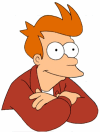 , the producers at first had chosen actor and comedian Charlie Schlatter, but in the end they chose Billy West, who had already made a name for himself as a versatile voice actor in many animated series like Ren & Stimpy and Doug.
, the producers at first had chosen actor and comedian Charlie Schlatter, but in the end they chose Billy West, who had already made a name for himself as a versatile voice actor in many animated series like Ren & Stimpy and Doug.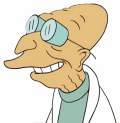 West had auditioned for several characters and at first had convinced Matt Groening and David X. Cohen as Fry's distant descendant Professor Farnsworth and the crab-like Planet Express company medic Dr. Zoidberg, before he was also chosen for the main character. Even very early in the series, Billy West demonstrated his enormous talent in his numerous different roles, which went from Fry's relatively normal voice to the blubbering crustacean Zoidberg and the grumpy old Professor Farnsworth - and none of his characters sound the same.
West had auditioned for several characters and at first had convinced Matt Groening and David X. Cohen as Fry's distant descendant Professor Farnsworth and the crab-like Planet Express company medic Dr. Zoidberg, before he was also chosen for the main character. Even very early in the series, Billy West demonstrated his enormous talent in his numerous different roles, which went from Fry's relatively normal voice to the blubbering crustacean Zoidberg and the grumpy old Professor Farnsworth - and none of his characters sound the same.
The producers were also very lucky with the casting of the one-eyed, purple haired Leela. Although they had at first chosen the comedian Nicole Sullivan, who had been very successful since the mid-1990s in the sketch series MadTV, they were able to go back to their original idea and win over the multi-talented Katey Sagal. She first became famous appearing for more than a decade in the sitcom Married... with Children as Peggy Bundy, but she was also a very good character actress and amazing singer, whose unique voice was perfect for one of the key characters of Futurama. In contrast to most others of the other actors working on the series, she only took a single role, because she had never been a professional voice actress before and was not used to transform her voice at all.
in the sketch series MadTV, they were able to go back to their original idea and win over the multi-talented Katey Sagal. She first became famous appearing for more than a decade in the sitcom Married... with Children as Peggy Bundy, but she was also a very good character actress and amazing singer, whose unique voice was perfect for one of the key characters of Futurama. In contrast to most others of the other actors working on the series, she only took a single role, because she had never been a professional voice actress before and was not used to transform her voice at all.
Lauren Tom was also hired for only two characters: Professor Farnsworth' quirky,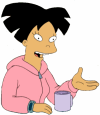 awkward and accident-prone intern Amy Wong and her mother Inez. For those two characters, the producers were looking for an actress with Asian background, because even though in the case of Amy no special accent was required, the ability to curse convincingly in Japanese and Cantonese was occasionally needed. Compared to Katey Sagal Lauren Tom had plenty previous experience in the voiceover business, because Futurama had not been her first work on an animated series and she also became the voice of several other characters later in the series.
awkward and accident-prone intern Amy Wong and her mother Inez. For those two characters, the producers were looking for an actress with Asian background, because even though in the case of Amy no special accent was required, the ability to curse convincingly in Japanese and Cantonese was occasionally needed. Compared to Katey Sagal Lauren Tom had plenty previous experience in the voiceover business, because Futurama had not been her first work on an animated series and she also became the voice of several other characters later in the series.
The only one borrowed from the Simpsons stable of voice actors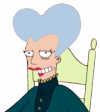 was the inimitable Tress MacNeille, who was responsible for many female Characters with a unique sandpaper voice absolutely indispensable for the Futurama producers. Mom, the evil, chain-smoking boss of a robot company empire had even been written with her in mind and became the biggest and most popular characters of the actress, who also had some smaller parts as the news anchor Linda, the mad old Lady Hattie and many others. In Futurama, she was as much omnipresent as in The Simpsons, although sometimes here characters are completely unrecognizable.
was the inimitable Tress MacNeille, who was responsible for many female Characters with a unique sandpaper voice absolutely indispensable for the Futurama producers. Mom, the evil, chain-smoking boss of a robot company empire had even been written with her in mind and became the biggest and most popular characters of the actress, who also had some smaller parts as the news anchor Linda, the mad old Lady Hattie and many others. In Futurama, she was as much omnipresent as in The Simpsons, although sometimes here characters are completely unrecognizable.
At first, David X. Cohen and Matt Groening had no idea how a robot should sound like and to find a voice for the drunken, loud and lazy Bender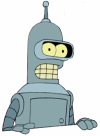 was not easy. A lot of actors had auditioned for the role, but only one was able to convince the producers - John DiMaggio, a former standup comedian, who had been a regular in many 1990s television series and movies, but had only occasionally provided voices for animated series. Like many other actors, he had tried our for a lot of characters, but the producers especially liked his interpretation of Professor Farnsworth - although they thought that this particular voice would be a better match for Bender. So the robot got his characteristical cheeky and slightly drunken voice and his very first line "Bite my shiny metal ass!" became one of the most recognizable trademarks of the series.
was not easy. A lot of actors had auditioned for the role, but only one was able to convince the producers - John DiMaggio, a former standup comedian, who had been a regular in many 1990s television series and movies, but had only occasionally provided voices for animated series. Like many other actors, he had tried our for a lot of characters, but the producers especially liked his interpretation of Professor Farnsworth - although they thought that this particular voice would be a better match for Bender. So the robot got his characteristical cheeky and slightly drunken voice and his very first line "Bite my shiny metal ass!" became one of the most recognizable trademarks of the series.
The voice of spaceship captain Zapp Brannigan the producers had originally been cast with Phil Hartman, an old friend of the producers, who had also voiced the slimy lawyer Lionel Hutz and the down-and-out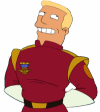 actor Troy McClure in The Simpsons. But a tragic event had prevented Hartman from taking on this key role when he was murdered by his own wife in May 1998, silencing one of the great voices of the animation business. While his characters on The Simpsons were retired out of respect for his passing and were not given to other actors, Matt Groening and David X. Cohen decided to recast the voice of Zapp Brannigan on short notice. There was only one reasonable choice, though: Billy West, who was not only able to simply imitate Phil Hartman, but to also turn the role into a deft parody of testosterone-soaked macho characters and a hefty chunk of Captain James T. Kirk and his actor William Shatner.
actor Troy McClure in The Simpsons. But a tragic event had prevented Hartman from taking on this key role when he was murdered by his own wife in May 1998, silencing one of the great voices of the animation business. While his characters on The Simpsons were retired out of respect for his passing and were not given to other actors, Matt Groening and David X. Cohen decided to recast the voice of Zapp Brannigan on short notice. There was only one reasonable choice, though: Billy West, who was not only able to simply imitate Phil Hartman, but to also turn the role into a deft parody of testosterone-soaked macho characters and a hefty chunk of Captain James T. Kirk and his actor William Shatner.
The further secondary characters were also perfectly cast mostly with the best professional voice actors the producers could find. Phil LaMarr primarily voiced the Planet Express manager, bureaucrat and
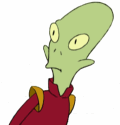 accountant Hermes Conrad, who was originally named Dexter and was only very late in the production turned into an Jamaican, giving the actor the chance to develop a pronounced accent and the writers to give him many memorable catchphrases. On the other hand, his fellow cast member David Hermann did not yet have a regular character yet, mostly voicing smaller roles like the mayor of New New York and Professor Farnsworth's nemesis Dr. Wernstrom. With Zapp Brannigans tortures assistant Kif, the robot television star Calculon, Lrrr, the ruler of the Omicronians and the television anchor-monster Morbo, Maurice LaMarche was even more busy but still managed to give each of his characters completely different voices.
accountant Hermes Conrad, who was originally named Dexter and was only very late in the production turned into an Jamaican, giving the actor the chance to develop a pronounced accent and the writers to give him many memorable catchphrases. On the other hand, his fellow cast member David Hermann did not yet have a regular character yet, mostly voicing smaller roles like the mayor of New New York and Professor Farnsworth's nemesis Dr. Wernstrom. With Zapp Brannigans tortures assistant Kif, the robot television star Calculon, Lrrr, the ruler of the Omicronians and the television anchor-monster Morbo, Maurice LaMarche was even more busy but still managed to give each of his characters completely different voices.
In the first season, guest stars were still relatively rare, but the producers were still able to get quite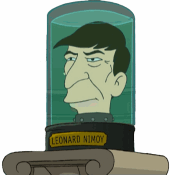 a few actors and celebrities interested in Futurama, although most of them played themselves. Leonard Nimoy had already been a guest on The Simpsons twice previously and was delighted to make a surprise appearance in the pilot episode, in which television moderator legend Dick Clark also shows up in a parody of his long-running new year's eve show. Surprising was also that Pamela Anderson voiced herself in her very short scene in A Fishful of Dollars and the appearance of marketing king Ron Popeil as the inventor of the head-in-jars technology was maybe the biggest in-joke of the series. Musical guests were also a part of the series with the Beastie Boys in the episode Hell Is Other Robots, which also has the robot devil with Homer Simpson's voice Dan Castellanetta as the only real guest voice actor.
a few actors and celebrities interested in Futurama, although most of them played themselves. Leonard Nimoy had already been a guest on The Simpsons twice previously and was delighted to make a surprise appearance in the pilot episode, in which television moderator legend Dick Clark also shows up in a parody of his long-running new year's eve show. Surprising was also that Pamela Anderson voiced herself in her very short scene in A Fishful of Dollars and the appearance of marketing king Ron Popeil as the inventor of the head-in-jars technology was maybe the biggest in-joke of the series. Musical guests were also a part of the series with the Beastie Boys in the episode Hell Is Other Robots, which also has the robot devil with Homer Simpson's voice Dan Castellanetta as the only real guest voice actor.
A completely new World
Above all, Futurama is, in principle, a typical workplace sitcom, only happening in an unusual setting. The Futurama universe was not intended to be an utopia like Star Trek or the only other animated science-fiction series The Jetson's, but also not a dark dystopian future vision like Ridley Scott's Blade Runner. Instead an elegant compromise was found which did not let the year 3000 appear to unfriendly and strange, but also did not refrain from some darker aspects. The 31st century is mainly a background for everyday satire and holds up a mirror to the present in an often snarky and cynical way.
The Futurama producers had a lot of fun with the technological advances of the future, but because many of the authors have a scientific background, there was a big emphasis on the plausibility of the numerous inventions and novelties. Some of it was just filed under artistic licence or even silly fun, but Futurama was easily available to afford this, because the series never had the ambition to be "hard" science-fiction. Instead it was always meant as a loose combination of parody, comedy and space adventure, excelling in all three directions and often being much more. Of course there were plenty of typical science fiction elements like spaceships, occasional space battles and travels to alien planets, but always with a special sense of humour.
To get a connection to the present and especially to make guest appearances of today's celebrities possible, Matt Groening and David X. Cohen thought up a little trick by inventing the technology of preserving living heads in jars. This was demonstrated very early in the first episode with the introduction of the Head Museum, containing numerous stars, politicians and other famous people not just from our own present, but also the past - including even Matt Groening and none other than Leonard Nimoy playing himself as the curator. The heads in the jars have an everyday presence in Futurama and are not just a throwaway gag, but a major plot element often used to great effect.
Futurama's humour is not vastly different from The Simpsons, although the situation comedy is much more refined and pronounced thanks to the new characters and the fresh scenery. The team of authors already had many brilliant humouristic ideas, almost all of which worked well and seldom seriously bombed. The typical, even sometimes naughty sitcom gags were combined with a lot of intelligent humour, parodies and satire, which were capped off with many surprisingly complex and elaborate references to the science fiction genre and many scientific details. Quite often the humour turned cynical and downright wicked, because along with The Simpsons the series had a program slot in the evening, allowing it much more freedom than other children-friendly animated series. Therefore the target group was hardly the younger generation, instead the series focused heavily on adults.
Tales from the Future
The thirteen episodes of the first production season mainly served as an introduction of the characters and the scenery. The first three episodes alone solely belong to the Planet Express crew and worked on creating the status quo of the delivery company setting to which most stories go back to in the end. The authors are somewhat resetting the scenery after each episode, but the plots are still based on each other and not only the framework, but the characters slowly, but noticeably start to develop even in the early episodes of the first season.
While some episodes are at first focusing on the adventures of Fry, Leela and Bender as the delivery crew of Planet Express, other stories are more about the characters themselves. I, Roommate cements the sort-of-friendship between Fry and Bender, Love's Labours Lost in Space not only introduces Leelas pet Nibbler, later one of the key figures of the series, but also Zapp Brannigan and his obsession with her. A Fishful of Dollars marks the first appearance of Mom, the head of the robot company empire and Fry's character also receives more attention. Futurama also makes first contact with extraterrestrials in When Aliens Attack, satirizing the genre from bottom to top and bringing the Omicronians as the go-to alien invaders into the spotlight. The lazy, but sometimes unavoidable monster-of-the-week scheme is only rarely used and when, like in My Three Suns, it's always in a very original way and even becomes a sort of running gag after a while.
While episodes like Love's Labour Lost In Space and A Flight to Remember fully earn their status as full-blooded science-fiction, other stories like I, Roommate or A Fishful of Dollars were completely earth-bound and worked almost like any other sitcom - those were actually a way of the series producers to satisfy the demands of Fox not to make the series too nerdy and out of this world. There is also no shortage of parodies and satires - Mars University borrows heavily from classic college comedies, A Flight to Remember takes on the then still almost new Titanic spectacle and the final episode from the first production batch, Fry and the Slurm Factory, of course takes its cue from Roald Dahl's Charlie and the Chocolate Factory. With A Big Piece of Garbage the authors successfully ventured into ecological and environmental satire and one of the biggest highlights was the Bender story Hell is other Robots, which for the second time after Fear of a Bot Planet concentrated solely on the robot and also addresses religion and addiction in a remarkable way.
The Universe from a Pencil
Stylistically, Futurama is almost undistinguishable from The Simpsons - Matt Groening's uncanny drawing style is very visible, because all the characters have their characteristic overbite and only four fingers. But in contrast to the predecessor, the yellow skin colour was not carried across, although otherwise the humans in Futurama look very much the same as in The Simpsons. The scenery is, however, much more elaborate, which not only had to show a futuristic New New York, but many other locations and even planets because the stories were never limited just to one place. With extensive research and the innovative work of production designers Serban Cristescu and Bill Morrison, a completely new animated world was created, making Springfield, the city of The Simpsons, look comparatively boring and ordinary.
While Futurama was mostly still drawn by hand and only then digitally scanned, there were occasional sequences with computer-produced, three-dimensional animations. With a special 3D rendering technique the CGI sequences did not actually look much different than the traditional animation, but thanks to the computer support, camera movements and other tricks were suddenly possible that could not have been achieved with hand-drawn animation. The best example is the amazing title sequence, which was created in the tradition of The Simpsons, but instead of a tour through Springfield makes a fast flight through New New York. The enormously elaborate scene was full of little details, in-jokes and other gags, setting the playful tone and the breathtaking scope of the series right at the beginning.
Space Opera 3000
Musically, Futurama only had the choice to differentiate itself from its predecessor, because Alf Clausen, house composer of The Simpsons, was already fully engaged with the series and furthermore not really familiar with the science fiction genre. Matt Groening and David X. Cohen, however, found a great alternative with Christopher Tyng, who was originally a drummer and started to work in the film music industry as a multi-instrumentalist. The producers were especially amazed by his ability to work with both traditional instruments and synthesizers and did not only hire him for the background score, but also to compose the title tune after they had heard some of his demo tapes.
The Futurama main theme actually turned out to be not completely new, but was based on the almost forty year old composition Psyche Rock by the French electronic music pioneer Pierre Henry. With this homage to the early efforts of electronic music in the 1960s, Christopher Tyng had successfully created a retro feeling combined with a very modern and futuristic sound, fully living up to the theme of the series. The background score itself was very much in the vein of the main theme and had its own original sound, which was at first mainly used in the short, often recycled jingles between episode segments. Because the series had always been heavy on dialogue, there was not much need for a constant background score, but when it was called into action, Christopher Tyng was able to create classical science fiction sounds on the level of Jerry Goldsmith, John Williams or James Horner with a brilliant orchestral sound opposed to the equally well arranged synthesizer music.
While The Simpsons often surprised with very successful song and musical interludes, there was some doubt if something like this would work in Futurama, too. But Matt Groening and David X. Cohen were able to transplant this tradition to the new series, beginning with the final episode of the first production season: Hell is other Robots did not only have a guest appearance from the Beastie Boys, but also the first original Song of the series, written by authors Eric Kaplan and Ken Keeler in collaboration with Christopher Tyng, who later contributed even more musical diversions for Futurama. The jazzy song was performed by guest voice actor Dan Castellanetta and regulars Billy West, John DiMaggio and Katey Sagal - the actress, who is also an accomplished professional singer, had a noticeable advantage over her co-stars, but even they sang remarkably well.
Matt Groening's Big Score
Futurama premiered on March 28th, 1999 in the USA and was broadcast right between The Simpsons and The X-Files on Sunday evening. Although Fox had not made a special effort for the publicity save for some short trailers, the favourable timeslot helped a lot and produced phenomenal ratings. It had been the best launch of a Fox program since decades, outdoing both other series. The second episode was also broadcast in this timeslot and produced similarly amazing ratings, but after that Futurama was bumped to another less ideal slot on Tuesday night in a block with three other animated sitcoms - and suddenly the ratings were only half as good as before. Matt Groening and David X. Cohen had then tried to persuade Fox to give Futurama its original timeslot back, because the joint broadcast with The Simpsons had demonstrably helped to boost both series - unfortunately to no avail.
Despite the unfavourable timeslot, Futurama had become an insider tip not only for Simpons fans during the broadcast of the first nine episodes from March 28th to May 18th, 1999. The ratings were still so high that Fox was willing to order more and the broadcast was later able to be continued with the four still unaired episodes from the first production season. Although the critics were at first not quite sure if Futurama was Matt Groening's masterstroke or just a one-hit wonder, but the more episodes aired, the more positive reviews appeared. The series was especially praised for its original scripts, the successful parody and satire, the detailed animation and the brilliant voice actors. Only Fox itself was never fully convinced of Futurama and always gave the series a second-class treatment, resulting in an early cancellation and two later comebacks - but in 1999 Futurama had a long and active life ahead of it.
The Episodes
- Space Pilot 3000 - Fry, a disillusioned delivery boy, is accidentally frozen in a cryogenic lab on New Year's Eve 1999 when all he wanted was to deliver a pizza ordered by a crank call. He wakes up a thousand years later and is actually happy to start a completely new life - if it wasn't for Leela, the beautiful one-eyed lab assistant who wants to implant a career chip into him, labelling Fry as a delivery boy forever....
- The Series Has Landed - Fry, Leela and Bender, the new crew of Professor Farnsworth's parcel delivery service Planet Express, are ready for their first assignment of taking a package to the moon - much to the joy of Fry, who already sees himself in the footsteps of Neil Armstrong, but first has to stand in line for the lunar amusement park.
- I, Roommate - Fry has taken up residence in the headquarters of Planet Express - to the annoyance of his co-workers, who promptly kick him out. Together with Bender he tries to find a new apartment when the robot's little quarters turn out to be so small for both of them, but this is easier said than done.
- Love's Labour Lost in Space -The crew of Planet Express gets the big assignment to save all animal species of a hollowed-out planet, but is stopped by the mighty spaceship captain Zapp Brannigan. When he tries to put his moves on Leela, to the amusement of everyone he actually succeeds...
- Fear of a Bot Planet - Bender has to deliver a parcel on a planet of human-hating robots, but gets in trouble despite being one of them. Fry and Leela decide to rescue him, but first they have to dress up and act as robots themselves...
- A Fishful of Dollars - Fry discovers, that the interest of his bank account has made him a trillionaire and spends lots of his money for things from his past - among them the last tin of anchovies in the universe. This brings him into the crosshairs of Mom and her robot empire, who intends to do something entirely un-culinary with the tinned seafood...
- My Three Suns - A delivery to a planet inhabited by lifeforms consisting of water takes a royal turn when Fry accidentially drinks the king and becomes the new head of state...
- A Big Piece Of Garbage - A giant ball of trash, which had been shot into space in the 21st century, comes on a return trajectory back to earth and threatens to strike down on New New York. The experts are clueless and Professor Farnsworth is battling with his nemesis Wernstrom about the correct countermeasure, but in the end it is Fry who has the right idea...
- Hell is other Robots - Bender tries in vain to give up his electricity addiction and becomes a member of the church of Robotology. But a relapse has terrible consequences for him and transports him straight to robot hell...
- A Flight to Remember - Professor Farnsworth treats his crew to a holiday on a cruise ship - unfortunately on the Spaceship Titanic, whose maiden voyage ends in a catastrophe thanks to Zapp Brannigan...
- Mars University - The new semester begins at Mars University and Fry has enrolled to finally become a proper college dropout. His greatest rival is an ape made intelligent by one of Professor Farnsworth's inventions...
- When Aliens Attack - Aliens from the planet Omicron Persei 8 are raiding the earth because they want to see the finale of an old television show which was knocked off the air 1000 years ago accidentially by none other than Fry himself.
- Fry and the Slurm Factory - After consuming an unhealthy amount of Slurm, Fry finally wins a visit to the famous Slurm factory, but his curiosity reveals a dark secret of the popular soft drink...
![]() The DVD
The DVD
Futurama had not been released on DVD first in the USA, but in Europe. The Region 2 DVDs only arrived about three years after the American television premiere and the US even had to wait an additional year to wait for the syndicated broadcasts. The first production season of Futurama was finally released on DVD in Europe in Spring 2002, which was especially good news for English-speaking fans in Germany, because the original version was not broadcast on German TV and the dubbing was so atrocious that the series was barely recognizable.
Even though the release was at first exclusive to Europe, 20th Century Fox had made the same effort with Futurama as with The Simspons and had not skimped on the special features: audio commentaries for every episodes, many deleted scenes and even more was offered on this inagural 3 disc set. It contains the first thirteen episodes of the first production season, although only the first nine were broadcast in the US as season one - the producers had decided to release Futurama on DVD divided into its production seasons, so that this first box contains all thirteen of them.
The episodes were split up on to three DVDs, although the material would have easily fitted on two dual-layer discs, like it was the case with the first Simpsons boxset. Instead of putting the discs into a folded digipack, Fox had used three single, clear Amaray keepcases contained in a fancy cardboard box with a plastic slipcover over it - while a digipack would have been better, this box has even more large-format artwork than the first Simpsons DVD set with a lot of funny details to look at.
The boxset reviewed in this article is the German release from February 2002, identical to the British and Australian DVDs save for some differences in the soundtracks. This set is still able to hold its own in terms of quality and content even today, especially because no other versions of the DVDs have ever surfaced - even the 2013 re-releases with the redesigned packaging are still the same under the hood. Although the quality of the Region 1 releases from March 2003 is slightly better because the NTSC format did not have to be converted to PAL, the difference is negligible and the European releases are still absolutely fine.



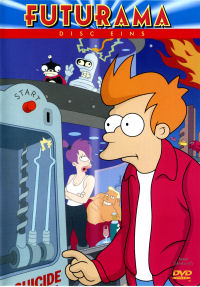
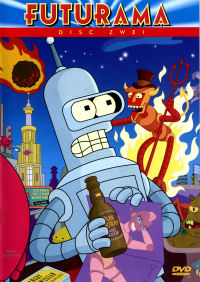
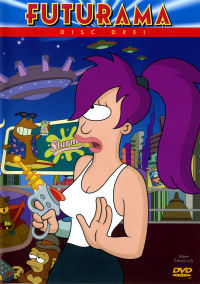
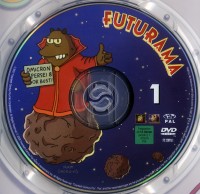
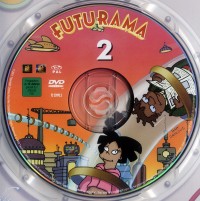


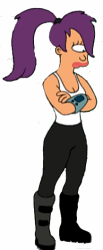


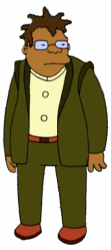
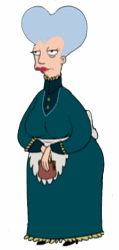
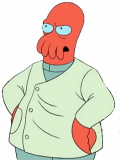


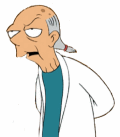
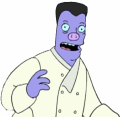

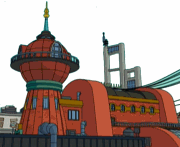


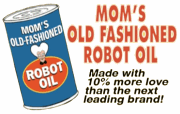
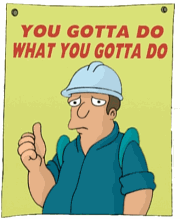
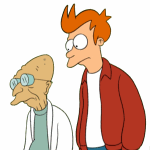

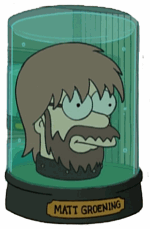
![]() Image
Image
In 1999, Futurama had been one of the very first animated television series produced completely on a digital basis - even The Simpsons were still produced on film at that time. Although the cels were still mostly drawn by hand and then scanned into computers, the post production was completely digital especially including the 3D sequences. At that time, the preferred image format was still 4:3, so all episodes of the first four production seasons of Futurama were still animated in 1.33:1.
The target format was a digital master, but for budget reasons the series was only animated in NTSC resolution. For the European DVDs, the image had to be upscaled to the slightly higher PAL resolution, which fortunately had only few negative effects. Most noticeable is a slight unsharpness on the edges, although they were still slightly soft in the original animation and did not look significantly different on the later American DVDs. Sharpness has not suffered from this, because a lot of detail like signs, letters and other inscriptions are perfectly discernible.
The colours are also perfectly reproduced by the digital master, although there are strange graduations in the backgrounds of some episodes, which look on first glance like compression artefacts, but were actually a part of the not yet quite perfect animation and are less visible in the later episodes. The compression shows despite very average bitrates that animation is actually not much of a problem for MPEG-2. Artefacts are rarely noticeable, only in some of the title sequences the image breaks up occasionally. Higher bitrates might still have been possible, because the file space on the three dual layer discs is only used by two thirds and all Episodes would even have fit on two completely full DVD-9.
The only real problem of these DVDs is that the image is largely interlaced, but this is excusable with television masters from 1999 and can easily be rectified by a good de-interlacer on progressive displays. The masters have actually been sped up correctly from 24 to 25 frames per second, so there is no ghosting visible when the DVDs are played back properly. Despite some limitations from the source, the first Futurama season still looks great even more than fifteen years after its debut.
![]() Sound
Sound
While even the first episodes of The Simpsons were treated to a 5.1 remix for the DVD release, Fox decided not make that effort with Futurama and just used the stereo surround tracks from the television broadcasts. The German DVDs have the original English soundtracks plus the German and Spanish dubs.
Despite the science fiction genre, the mix is mostly limited to the frontal soundstage, because the matrix-encoded surround channel is almost exclusively used by the music and only very rarely for sound effects. For a typical comedy mix, this soundtrack still sounds surprisingly wide thanks to the very active frontal soundstage with a very playful sound design. The voices fit right into the mix and are not always limited to the center channel, but are mostly anchored to it and in return always sound very warm and friendly. It's not exactly a match for an elaborate movie sound mix, but Futurama actually sounds very modern and even futuristic.
The German and Spanish soundtracks are not recommended because of their emotionless and flat voice delivery - the speakers are far away from creating the atmosphere of the original and just sound too artificial. The soundmix is otherwise identical to the original, but it is still better to listen to the English track and use subtitles, which are on the German DVD available not only in English and German, but also in three other European languages. Unfortunately the user prohibitions have been set so strictly that soundtracks and subtitles are only switchable over the menus if the player has not unlocked this feature.
![]() Extras
Extras
On first glance, the bonus materials of the first Futurama season look a bit sparse, but like the Simpsons releases, quality is more important than quantity. Instead of huge documentaries, the producers had decided on audio commentaries as the main feature with some additional smaller extras. The menu design is almost completely static, but each screen has been wonderfully designed and not just thrown together.
The Audio Commentaries are the undisputed highlight of the bonus materials. Matt Groening, David X. Cohen, Rich Moore and the respective directors and writers are heard on each of the thirteen episodes and even the voice actors Billy West and John DiMaggio sometimes join in. The commentaries are immensely entertaining and their informational value is undoubtedly high, but in some of the later episodes there is more occasional silence, as if too many episodes had been watched in a row and people got tired. The final episodes are more lively again and even the somewhat weaker commentaries are still so interesting that Matt Groening and his team cannot really be faulted if they sometimes just have nothing to say. It is great fun to listen to them because from the smallest anecdote to the most revealing detail there is so much to hear about the production and development history of the series that those commentaries easily double the runtime of these DVDs.
The further extras are spread over all three discs and have some small and big surprised to offer.
Disc 1
The Animatic from "Space Pilot 2000" (25:44) is located on the first disc - this black and white rough animation is not altogether easy to watch, but it's still interesting because of the early, unedited voice recordings and the look of the drawings.
The Script of the Pilot Episode including handwritten notes and doodles from David X. Cohen is available in its entirety in the DVD menu system and surprisingly well readable. A separate PDF version would have been nice, but the many differences and remarks make this early script very interesting.
The Space Pilot 3000 Storyboards also span the whole pilot episode. These drawings from RoughDraft are a surprisingly accurate representation of the final episode, even though they are just in black and white.
Deleted Scenes are available for the episodes The Series Has Landed, I, Roommate and Love Labour's Lost in Space on the first disc. Like on all other deleted scenes the image quality is just on VHS level and except the voices and some rudimentary sounds the audio is silent, but the scenes are still worth watching.
Disc 2
Deleted Scenes are available for My Three Suns and Hell is Other Robots on this disc.
The Trailer (1:29) for the first Futurama season is a somewhat lifeless promotion effort and basically just shows how badly Fox had managed the publicity of the series.
Disc 3
A single Deleted Scene for the episode When Aliens Attack is available on this disc.
The Featurette (4:53) is, unfortunately, not a real documentary, but just a short publicity making of. At least Matt Groening, David X. Cohen and Claudia Katz are heard in brief interviews and talk about the origin of the series and the animation technique.
The Gallery is surprisingly big with 64 images and has a lot of early concept drawings warranting a closer look. Each drawing has a text explanation and all artists are credited. Also, when a small colourful icon appears, there are short video statements from Matt Groening about the characters, which seem to have been culled from the same material as the featurette.
Some small, but funny Easter Eggs are located on all three discs, which are relatively easy to find, so I won't divulge their locations here and leave them as a surprise.
